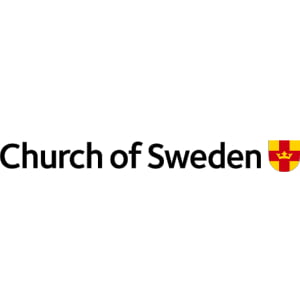
Church of Sweden
Portfolio level
Portfolio level – Portfolio decarbonisation reference target
Baseline date: December 31 2021*
*Latest data available in June 2023 – based on the portfolio in March 2023.
Baseline performance:
- Scope 1 & 2: 31.01 tCO2e/$mn USD revenue (WACI)
- Scope 1, 2 & 3: 670.08 tCO2e/$mn USD revenue (WACI)
Source: Sustainalytics
Benchmark comparison
Fund managers in scope for the baseline, listed equity and corporate fixed bonds, report carbon intensity in the fund portfolios that is on average around 50% lower than the benchmarks used. Church of Sweden has not yet chosen an appropriate benchmark for comparison but comparing the 2021 baseline performance for scopes 1 and 2 with the MSCI ACWI benchmark Carbon intensity was 135 (tCO2e/$mn USD sales). The MSCI Climate Paris Aligned benchmark was 39 (September 2023 MSCI report).
Coverage: 92.76% (% of holdings/total holdings in the two asset classes Listed equity and corporate fixed bonds)
Number of constituents: 306 included
Coverage of total portfolio: 57.8%
Target year: 2030
Target(s):
- –25%* tCO2e/$mn revenue by 2030 (Scope 1, 2 & 3)
- Targets for 2035, 2040 TBD in forthcoming climate strategy.
*Please note that referring to our baseline emissions, Church of Sweden already has a low emitting portfolio due to an adoption of exclusion criteria concerning oil and coal in 2009 and gas in 2014. Thus, Church of Sweden should be considered having taken a fair share of emissions reduction already. A 25% reduction target to 2030 should be seen as very ambitious. This might be subject to revision in forthcoming climate strategy.
GHG scopes included: Scope 1, 2 and 3 for all listed equity and corporate fixed income (reported and estimated), covering over 90% of the constituents in those portfolios).
Asset classes in scope:
- Listed equity and corporate fixed income
- Planned integration in 2025: Real estate, government bonds
- Planned integration in 2030: Alternative investments (non-listed), if possible/relevant
Methodology/net zero scenarios: The IPCC Special Report on 1.5 degrees serve as a basis for our overarching strategy for Church of Sweden, the Church of Sweden’s Roadmap for the Climate. The roadmap is being revised by the Church Board, for 2024-2027. Available December 2023.
Financed emissions is one core element of this strategy. The Net Zero Investment Framework guidance (1.0) serves as the basis for the Church of Sweden target setting and as a guidance for the forthcoming climate strategy covering all asset classes.
Portfolio level – Investment in climate solutions target
Qualitative goal
Approach: No specific percentage target yet for investment allocation to climate solutions, but 10% of the portfolio has been allocated for alternative investments which traditionally is where we have our investments for sustainable solutions.
In addition the instruction to external asset managers include an emphasis on holdings in actors involved in climate solutions. The forthcoming climate strategy will provide insight as to how this will be monitored via asset managers.
A forward-looking climate investment strategy is forthcoming (spring 2024).
Asset level
Asset level – Portfolio coverage target
Baseline: June 2023: 54% of holdings are SBT committed.
Target year: 2025, 2030
Target:
- 2025: 50% of holdings shall disclose reduced emissions, with SBTi-approved targets.
- 2030: +90% of the holdings shall disclose reduced emissions, with SBTi-approved targets, thus covering the Net Zero Investment Framework alignment criteria 2, 3 and 4.
Asset classes in scope: Listed equity and corporate fixed income.
Data sources: SBTi and external asset managers.
Additional information: Dialogue to be held with external asset managers in 2023/2024 to improve reporting on holdings in relation to SBT.
Asset level – Engagement threshold target
Approach: Engagement is carried out primarily by contracted asset managers.
Target for holdings TBD
Additional information
Methodology: The low carbon intensity of the portfolio (data from March 2023 on holdings December 2021) means the Church of Sweden is, in our opinion, on track to a 2030 emissions reduction considering a ‘fair share’-perspective. The 25% reduction to the 2030 target is ambitious compared with the 2021 baseline emissions.
The forthcoming climate strategy is set to include targets for our contribution to real economy decarbonisation. We are currently not sure how such a strategy, involving all asset classes, will coexist with a low carbon intensity portfolio target in the short term, to 2030. We are reviewing how to balance our low carbon intensity approach with a more forward-looking approach. The strategy is yet to be developed (spring 2024).
Operational emissions: The operational level emissions specific to managing the investments are negligible, as the office managing the investments constitutes less than 1% of the organizational manpower overall.
For the national level of the Church, the Church Board’s Roadmap for the Climate, targets 2030 for carbon neutral operations. This is achieved by limiting Scope 1 and 2 emissions to a possible minimum and offsetting the remainder. It includes also Scope 3 emissions, but where the offsetting strategy is not decided yet. A baseline including Scope 3 is on the way.
A Carbon Neutral Church by the end of 2030, includes operational emissions (Scope 1 and 2), value chain emissions (Scope 3, 1-14) and financed emissions. (Scope and definition subject to scrutiny by the Church Board).
Fossil fuel investment: Church of Sweden divested from fossil fuels in 2014, a process started in 2008. See here.
The CoS finance policy prohibits investments in fossil fuels, by exclusion criteria. Sustainable investments; Annual reports
Church of Sweden’s Roadmap for the Climate (English version available on request); Bishop’s letter;